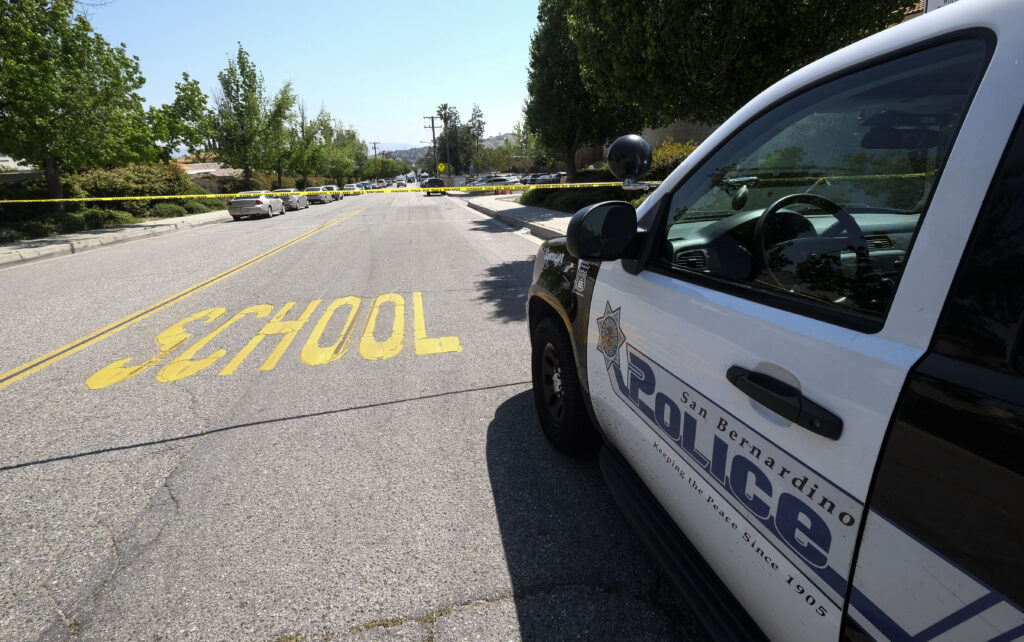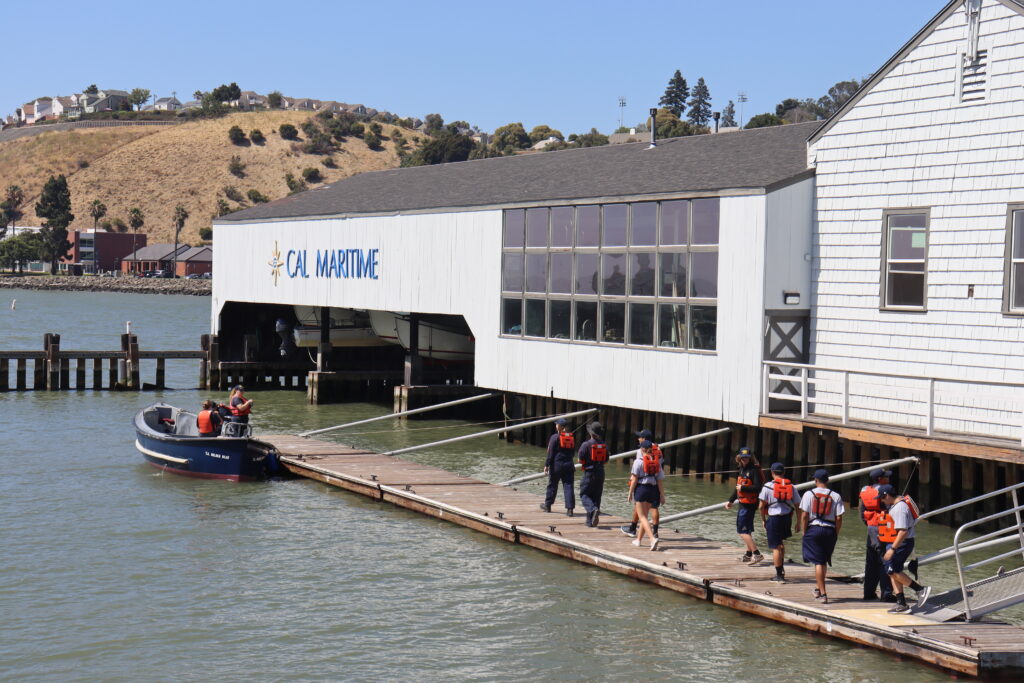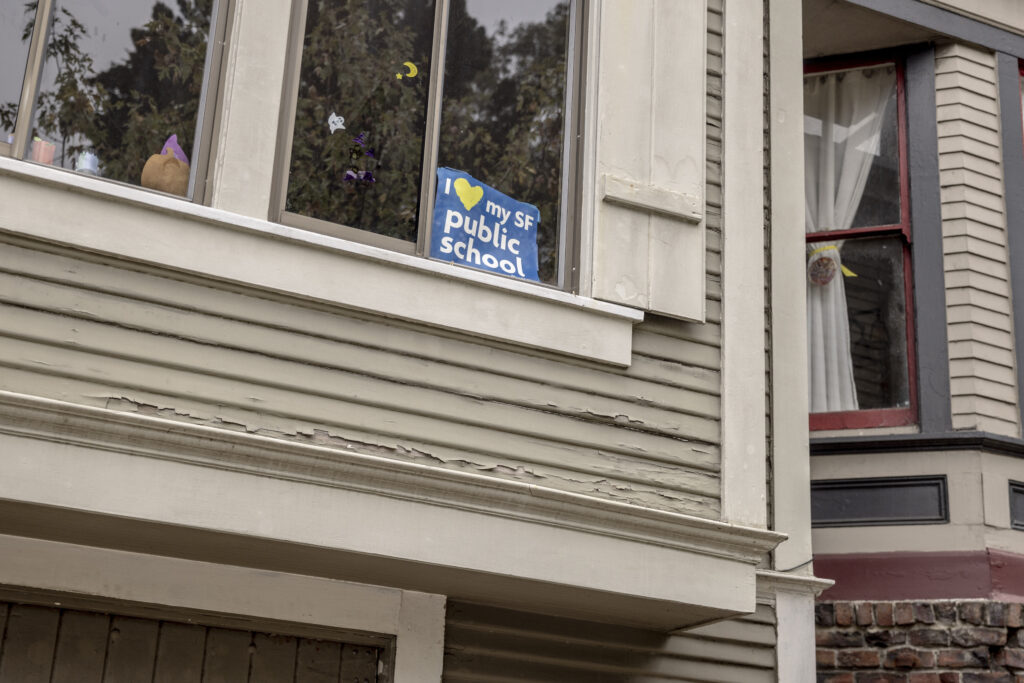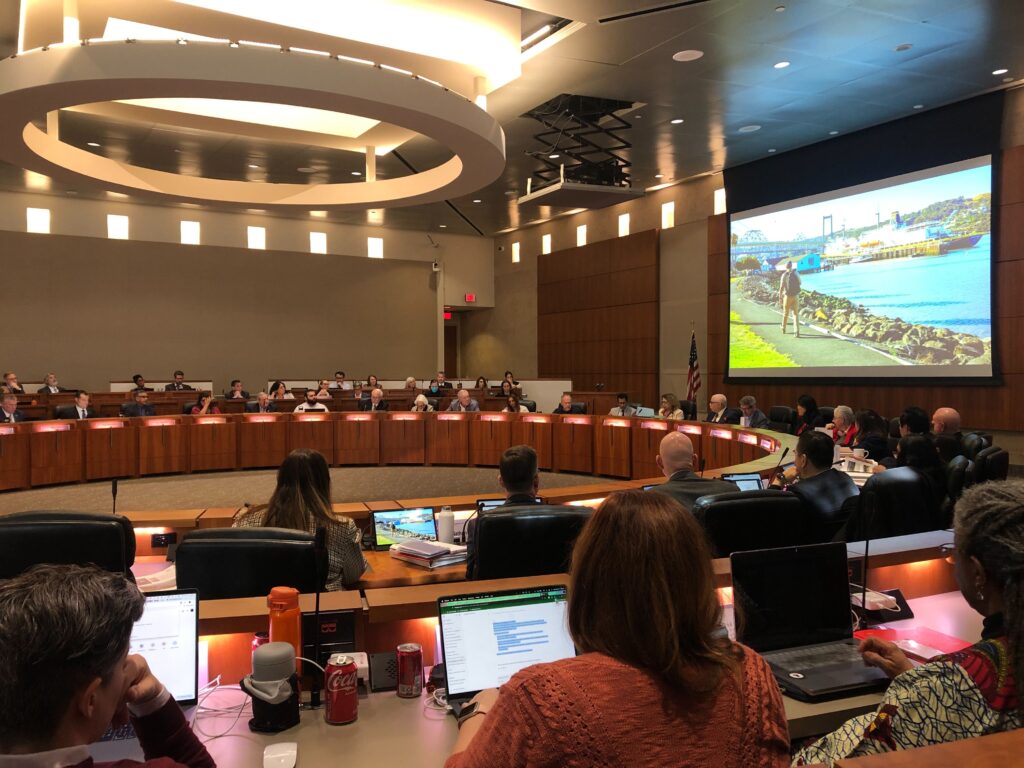In eastern San Bernardino County, a cluster of five school districts take a different approach than nearly all the rest of California when it comes to school policing: they not only buy books for kids, they also buy bullets for cops. They run their own police departments.
There are just 19 school-run police forces in California spread over 10 counties. They include Los Angeles and San Diego unified, the state’s two largest districts. In all, 15% of California K-12 students — more than 863,000 kids — attend districts with their own police departments.
Those students are more likely to be exposed to police than students whose schools rely on officers from municipal police departments or sheriffs offices to respond, a far more common model, an EdSource analysis shows.
Studies show that student exposure to police raises fear and anxiety, especially for students of color who come from over-policed communities where friction with, and distrust of, police are common. A 2021 study by the American Civil Liberties Union (ACLU) of Southern California found that students of color and disabled students were far more likely to be arrested in schools with assigned officers than those without. Black students’ arrests were 7.4 times higher in schools with assigned law enforcement.
Outside of San Bernardino, school-run police departments are waning. Oakland Unified disbanded its force in 2020 after the videotaped murder of George Floyd, who died at the hands of city police in Minneapolis. Baldwin Park Unified in Los Angeles County closed its in 2021. Inglewood Unified’s will shutter at the end of this month. San Jose’s has but one officer — its chief.
Combined, the 19 school police departments in the state have fewer than 500 officers, state records show. Some have as few as four. Others have had troubles: police chiefs sued, arrested and a department sharply criticized for abusing students. The unified districts with their own police departments are: Apply Valley, Hesperia, San Bernardino City, Fontana Unified and Snowline Joint.

But San Bernardino’s cluster will soon expand. Trustees of the Victor Valley Union High School District, based in Victorville, voted in March to form a police department and begin searching for a chief to head it.
“We need to take our safety to another level,” district Superintendent Carl Coles said prior to the board’s unanimous votes. He cited no crime data or examples of student violence. He told EdSource by email that student suspension rates declined in the last year.
Among the reasons he gave in March: Victor Valley needs to keep up with its neighbors, five districts that have their own police departments, rather than rely on school resource officers provided by contract with the county sheriff.
Board members were quick to agree.
“The way things are right now, our resource officers, they get called away and sometimes you never see them,” trustee Rosalio Hinojos said before the vote. School-employed officers are more stable, always on campuses and “have a good rapport” with students, he said, referring to districts that employ their own officers. “I don’t think that’s happening right now.”
Just before the vote, Hinojos struck an ominous tone, saying it was “not a question of if, but a question of when” police would be needed in the nine-school district. He declined an EdSource request to clarify the remark.
Why San Bernardino?
San Bernardino, the largest U.S. county outside of Alaska and nearly the size of West Virginia, isn’t a place where much discussion about defunding police departments occurred after Floyd’s murder. It’s so deeply conservative that voters approved a 2022 ballot measure instructing officials to explore seceding from California.
“When you look across our county, we do have pockets of areas that may statistically have more crime that takes place,” San Bernardino County Schools Superintendent Ted Alejandre told EdSource.
“That may be one influence on why a school may want to have more protection.” He said his office gives no guidance on the matter, but added that local superintendents and school board members in the Inland Empire have deep interests in “keeping their campuses safe.”
In Fontana, a city of 212,000 known for its steel mill and NASCAR track, school police are deployed “full force at the high schools and middle schools and elementary schools,” board President Marcelino Serna said in an interview.
He cited fear of “school shootings” and potential threats “of people coming on campus,” as primary reasons for the department’s existence. “It’s sad that anyone would want to commit harm to any children. We’re always having to be vigilant.”
The department had 15 sworn officers as of April, state records show. The cops, Serna said, like to show off their police cars and dogs to students, as well as “their weaponry, if kids are wanting to see that.”
In nearby Apple Valley, a town of 75,000, police presence on campuses became spotty because deputies from the San Bernardino County Sheriff’s Department were often called away from schools to perform other duties, Rick Roelle, an Apple Valley Unified School District board member and retired sheriff’s lieutenant, said in an interview.
That “would leave the schools kind of high and dry,” he said. The district formed its own police force in 2002. It had nine officers as of April, records show.
Apple Valley Unified has experienced rises in “drug use, violence and disruptive behavior,” Roelle said. “What we’re seeing today is violence where kids are getting kicked in the head, and they’re getting smashed up against walls, and they’re getting severely injured on campus. So, if there’s no police there to take someone into custody for doing that, who’s going to do it?”
An EdSource investigation into school policing gathered nearly 46,000 logs of calls for police from and about a sample of California schools from Jan. 15, 2023 to June 30, 2023. In Apple Valley, 4.9% of its nearly 1,500 calls were for fights, assaults, battery, and disturbing the peace — the second-lowest rate among the 10 districts with their own police departments included in EdSource’s sample. Inglewood Unified led the category with nearly half of its 196 calls reporting such events.
Apple Valley Superintendent Trenae Nelson declined interview requests, as did school Police Chief Cesar Molina. Nelson also didn’t respond to emailed questions about the police department.
Comparing districts with their own police and those that rely on outside departments:
- Students in high schools with district-run police were more likely to encounter officers than other high schools. The average number of calls for police was 88 in districts with their own departments compared with 57 in districts with outside police.
- School districts that employ police officers break up fights more than other districts: 4.6% of incidents in high schools without in-house departments were calls about fighting or disturbing the peace, compared with 6.6% in high schools with outside police.
- School district police officers are dispatched to counsel students over 10 times more than other officers. In the 76 high schools with their own departments, police officers were dispatched to counsel students 63 times, and in the 209 high schools without their own district officers, they were called 16 times.
Police “really are just ill-suited to address mental health concerns, not because of training, but really it’s not their role or their expertise to be handling these types of things,” said Cal State Long Beach education associate professor Caroline Lopez-Perry, who studies school counseling.
Carl Cohn, a former State Board of Education member and superintendent at Long Beach Unified in the 1990s, said he was pressured to create a district police department by the school board after the 1992 riots triggered by the police beating of Rodney King in Los Angeles.
A board member who was a Los Angeles County deputy sheriff “was adamant we needed it,” Cohn said.
But Cohn said he was skeptical, thinking, “Do we need to take scarce resources and actually set up our own school-district police force?” He had long meetings with city officials trying to create a coverage plan using Long Beach police officers that would meet district needs. When the department’s chief told him, “‘Look, if we can’t protect kids we shouldn’t be in business,’’ he went with the city. It was a decision he doesn’t regret. Other superintendents have expressed regrets to him over having school departments, calling them a financial drain, he said.
Who’s watching the watchers?
When school officials sign contracts with cities or sheriffs for school policing or just rely on responses to 911 calls, they tap into a system where a city manager oversees police, and in some cities where police commissions add a level of oversight. Elected sheriffs are answerable to voters about their departments.
When school districts create their own police departments, they take on that oversight themselves, which in California comes with laws limiting public accountability and granting officers deep job protection and privacy rights.
“Police just do a better job when they have accountability,” said Lauren Bonds, executive director of the National Police Accountability Project, a nonprofit watchdog. At small agencies like school-police departments, more power is vested in fewer individuals, like a chief or small cadre of officers. They may not have trained internal affairs investigators, leaving chiefs to conduct their own misconduct probes. “There’s just not the infrastructure.” At small public agencies, “There’s little oversight that’s happening outside of the department as well.”
A leading California policing expert agreed.
“Any department or any entity that polices itself is ripe for corruption,” said retired state Superior Court Judge LaDoris H. Cordell, the first Black woman appointed to the bench in Northern California. She also worked for five years as the City of San Jose’s independent police auditor.
In response to EdSource questions to districts regarding outside oversight, officials at seven districts reported having none. Stockton Unified reported it has a community advisory group “which meets quarterly and reviews quarterly reports on employee statistics, complaints, and calls for service,” Superintendent Michelle Rodriguez told EdSource. In Riverside County, Val Verde Unified has a group of students, parents and others that meet with police but don’t have oversight authority.
While independent oversight of all law enforcement is critical, Cordell said, it should be especially so for school-run departments, considering they primarily police children. As San Jose’s police auditor, she published a multilanguage student handbook titled “A Student’s Guide to Police Practices” that advised juveniles on their rights during police encounters.
Her main concern about school policing, she said, is inequitable treatment of students of color. Some police “focus primarily on kids of color, Black and brown kids,” she said. “Just the melanin in the skin raises suspicion.”
Scandals
In April, the state Department of Justice (DOJ) ended five years of oversight of the Stockton Unified police after an investigation found officers “routinely violated the civil and constitutional rights of Black and Latino students and students with disabilities.”
DOJ investigators found police routinely arrested the students for “defiance, disorderly context, fights without injuries, using profanity and loitering” that civilian personnel should have handled.
“School police were out of control, arresting and traumatizing kids for acting like kids,” Linnea Nelson, a senior staff attorney at the ACLU of Northern California said in a statement. “Those disparities still exist, and we will continue to monitor the District’s progress to prevent resurgent discrimination.”
Stockton school police took “important steps to address concerns regarding
interactions between police officers and students and to promote an equitable and positive learning environment,” Attorney General Rob Bonta said in a statement.
There have also been problems at school police departments involving leadership.
A former chief and lieutenant of the Inglewood school police department are scheduled for sentencing Thursday in Los Angeles Superior Court after being charged in a 2022 corruption investigation.
According to court records, the former department lieutenant, Timothy Marks, hired then-Chief William T. Carter as a security guard at a marijuana facility in San Bernardino County. Carter worked there when he was supposed be on duty at the police department. He “boasted to his security coworkers of his ability to do whatever he wanted because he was a police chief,” prosecutors wrote in court papers, adding, Carter drove his school-police car to the job “using his lights and sirens to get there faster.”
After being charged with embezzlement, conspiracy and perjury, Carter and Marks both cut deals and pleaded no contest in April to petty theft. Carter agreed to repay the district $15,722 and Marks, $3,006. The agreement calls for each man to be sentenced to 50 hours of community service and a year of probation.
James Morris, a former school superintendent who is working to help the district out of years of state receivership because of fiscal woes, said he is “pleased that the outcome will return funding to the students of Inglewood Unified.”
In San Diego, Chief Alfonso Contreras of the school district police department abruptly retired last month after less than two years in the post after 11 officers — nearly a third of the department’s ranks — sued him in December. Those officers alleged that Conteras and several supervisors who are his friends, and one with whom he is romantically involved, discriminated against others based on sexual orientation, gender and race. Conteras had been on paid suspension since January. The lawsuit remains in early stages, court records show. San Diego Unified spokesperson Maureen Magee said she couldn’t discuss ongoing litigation.
A chief’s perspective
The president of the California Association of School Police Chiefs disagrees that these agencies, typically smaller than most municipalities’, need more oversight.
At smaller agencies, “you have to be even more critical of your department and policies to ensure you are always in compliance,” Mark Clark, chief of the Val Verde Unified School District Police in Perris, Riverside County, wrote in an email in response to questions.
Clark, who’s spent his career at school departments, said that the in-school department offers school districts more control over how officers on their campuses are hired and trained.
Clark wrote that he formed Val Verde’s committee in 2017. It’s made up of parents, staff, students and other organizations within the district that have made recommendations to the board on procedures, staffing, and equipment. Although it is not an oversight panel, its input has been helpful, he said.
The committee, he said, has offered “nothing but support for hiring more officers.”
EdSource reporter Michael Burke contributed to this story.















